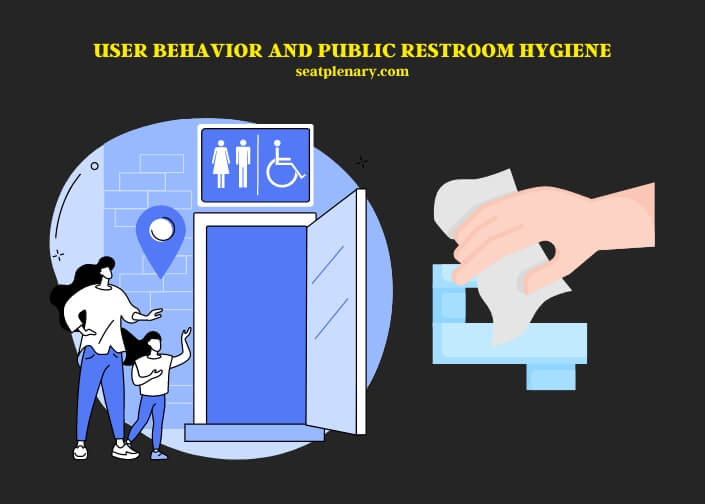Protecting yourself from germs is essential in public restrooms. Placing paper on toilet seats can be a simple yet effective hygiene practice.
Public restrooms are frequented by numerous people daily, making them hotspots for bacteria and viruses. These germs can include E. coli, streptococcus, and staphylococcus, which are known to linger on toilet seats. By placing paper on the seat, you create a barrier between your skin and these potential pathogens, reducing the risk of skin contact with harmful microbes.
Moreover, public toilets are not always cleaned as regularly or as thoroughly as they should be. Even if a toilet appears clean, invisible germs might still be present. Using toilet seat covers or toilet paper can provide peace of mind, especially in restrooms that seem inadequately maintained. This practice is particularly beneficial in high-traffic areas like airports, train stations, and shopping malls, where the turnover of users is high.

In addition to health reasons, using paper on toilet seats can also offer comfort. Public toilet seats can be cold or damp, and a paper barrier can make the experience more pleasant. It’s a simple step that can enhance your overall comfort in a public restroom.
For those interested in learning more about this topic, we invite you to read the detailed article below. It offers in-depth insights into the benefits of this hygiene practice and how it can contribute to your health and comfort in public restrooms.
Paper on Public Toilet Seats – A Smart Hygiene Practice
The Health Risks of Public Restrooms
Bacteria and Viruses on Toilet Seats
Did you know that public toilet seats can be a playground for germs? It’s true! These surfaces often harbor bacteria and viruses that can pose health risks. Let’s take a look at some common culprits:
| Germs | Diseases They Can Cause |
| E. coli | Gastrointestinal issues |
| Streptococcus | Throat infections |
| Staphylococcus | Skin infections |
These germs can survive on surfaces for hours, making public toilets a hotspot for potential infections.
Cross-Contamination Concerns
Cross-contamination in public restrooms is a real issue. It happens when germs from one person are transferred to another, often through shared surfaces like toilet seats. This is especially risky in restrooms with high foot traffic, where the turnover of users is constant.
Impact of High Traffic on Germ Spread
High-traffic areas like airports or malls see thousands of visitors daily. This constant flow increases the risk of spreading germs. Even with regular cleaning, it’s challenging to keep these spaces germ-free at all times.
The Science Behind Toilet Seat Covers
Material and Design of Seat Covers
Toilet seat covers are designed to create a barrier between you and potential germs. They’re usually made from paper or plastic and are shaped to fit the seat perfectly. This design helps to minimize direct skin contact with the seat.
Effectiveness in Blocking Germs
But how effective are these covers? Let’s compare:
| Material | Effectiveness |
| Paper | Good |
| Plastic | Better |
| Fabric | Varies |
While no material is foolproof, they all provide a significant barrier against germs.
Benefits of Using Paper on Toilet Seats
Preventing Direct Contact with Germs
Using paper on toilet seats is a simple yet effective way to avoid direct contact with germs. It acts as a physical barrier, keeping you safe from bacteria and viruses lurking on the seat.
Psychological Comfort and Peace of Mind
There’s also a psychological benefit. Knowing you’re protected can bring peace of mind, especially in less-than-spotless restrooms. This small step can make a big difference in your comfort level.
Practicality in High-Traffic Public Restrooms
In busy public restrooms, using paper covers is a practical choice. It’s a quick and easy way to ensure hygiene, even when you’re unsure about the cleanliness of the space.
Types of Toilet Seat Covers
Disposable Paper Covers
Disposable paper covers are the most common. They’re convenient, easy to use, and you can find them in many public restrooms. Plus, they’re often biodegradable, which is great for the environment.
Reusable Seat Covers
Reusable covers are another option. They’re typically made of washable fabric and can be a good choice for those who frequent public restrooms.
DIY Alternatives Using Toilet Paper
No covers available? No problem! You can create a DIY barrier using toilet paper. It’s not as effective as a proper cover, but it’s better than nothing.
Environmental Considerations
Biodegradability of Paper Covers
Many paper toilet seat covers are biodegradable, which is a win for the environment. They break down easily and don’t contribute to landfill waste.
Impact on Waste Management
| Cover Type | Environmental Impact |
| Paper | Low |
| Plastic | High |
| Fabric | Minimal |
Choosing biodegradable options like paper can help reduce environmental impact.
User Behavior and Public Restroom Hygiene

Public Perception of Restroom Cleanliness
People’s perception of restroom cleanliness can vary. Some may avoid using public restrooms altogether, while others are less concerned. This perception often influences their hygiene practices.
Hygiene Practices Among Different Demographics
Different groups of people have varying hygiene habits in public restrooms. Some are meticulous about cleanliness, while others are more relaxed. Understanding these differences can help in promoting better hygiene practices for all.
Frequently Asked Questions (FAQs)
Can Germs Penetrate Through Paper Toilet Seat Covers?
While paper toilet seat covers provide a barrier, they’re not completely impenetrable. Most germs and bacteria cannot easily pass through these covers due to their size and the material’s density.
It’s important to note that these covers are more about providing a psychological comfort than a foolproof barrier. They significantly reduce direct skin contact with the seat, thereby lowering the risk of germ transfer. But for tiny, microscopic pathogens, especially viruses, the protection might not be absolute. Still, using a paper cover is a better option than direct contact with the seat.
Is Squatting Over the Toilet Seat Really Unhygienic?
Many experts agree that it is best to avoid squatting on toilet seats in public restrooms, as this can lead to unsanitary conditions. By using disposable seat covers or squatting over a toilet, individuals can minimize the risk of coming into contact with harmful bacteria and viruses.
Is It Necessary to Use a Cup Under the Toilet Seat if I Can Just Use Paper on Public Toilet Seats?
Using a practical toilet seat solution like a cup under the toilet seat may provide better protection than just using paper on public toilet seats. The cup creates a physical barrier between you and the potentially dirty seat, offering greater peace of mind.
Can Putting Paper on Public Toilet Seats Cause them to Turn Pink?
Some people believe that putting paper on public toilet seats can lead to pink stains. While this is a common myth, the truth is that the pink stains are caused by a bacteria known as Serratia marcescens. Regular cleaning and disinfecting are crucial for eliminating pink toilet stains.
Are Open Toilet Seats in Public Restrooms More Sanitary Than at Home?
When it comes to open toilet seat risks, public restrooms may actually be more sanitary than at home. Public restrooms are often regularly cleaned and maintained, reducing the risk of bacteria and germs. However, using a toilet seat cover or wiping down the seat can further minimize any potential health hazards.
Do People’s Toilet Seat Preferences Extend to Public Restrooms?
When it comes to public restrooms, people’s toilet seat preferences may not extend to the same level of care as they do at home. A detailed analysis of toilet seat up habits in public facilities shows that the majority of users tend to leave the seat in whichever position they find it.
Is It Safe to Flush Paper Toilet Seat Covers?
Yes, it’s generally safe to flush paper toilet seat covers. These covers are designed to be flushable and biodegradable, meaning they break down quickly in water without causing blockages in the plumbing system. This is a key feature that differentiates them from other paper products like paper towels or facial tissues, which can cause clogs.
It’s always wise to use them sparingly and ensure that the plumbing in the facility can handle such materials, especially in older buildings or in restrooms with known plumbing issues.
Do Paper Toilet Seat Covers Really Keep You Clean?
Paper toilet seat covers can help keep you clean by providing a barrier between your skin and the toilet seat. This barrier helps to prevent direct contact with any residue or moisture left by previous users, which might contain bacteria or viruses. While they’re not 100% effective in blocking all germs, they do significantly reduce the risk of coming into contact with harmful pathogens. It’s a simple, yet effective way to maintain personal hygiene in public restrooms, especially in situations where the cleanliness of the toilet seat is questionable.
Can Using Paper on Public Toilet Seats Cause Sticky Toilet Seats?
Using paper on public toilet seats may seem like a good idea, but it actually contributes to sticky toilet seats causes. When the paper becomes moist or wet, it can stick to the seat and create a messy situation. It’s best to use toilet seat covers or clean the seat before use.
Are There Any Alternatives to Paper Toilet Seat Covers?
If paper toilet seat covers are not available, there are alternatives. One common method is to use toilet paper to create a makeshift cover. While not as effective as purpose-made seat covers, this can still provide a barrier. Another option is to carry disposable, biodegradable seat covers, which are available in travel packs. For those looking for a more sustainable option, reusable fabric seat covers that can be washed and reused are also available. These alternatives ensure that you have a protective barrier, even when paper covers are not provided.
How Often Should Public Restrooms Be Stocked with Paper Covers?
Public restrooms should ideally be stocked with paper covers regularly, depending on the frequency of use. High-traffic areas like airports, malls, and concert venues might require restocking several times a day. In contrast, a restroom in a small office might need restocking less frequently. The key is for the management to monitor usage and ensure a consistent supply. Regular checks and restocking help maintain hygiene standards and ensure that visitors always have access to these protective covers.
Can Using Paper Toilet Seat Covers Help Prevent UTIs?
Using paper toilet seat covers alone cannot prevent urinary tract infections (UTIs), as these infections are typically caused by bacteria entering the urinary tract, not by contact with toilet seats.
Using these covers can be part of good hygiene practices that help reduce the overall risk of exposure to harmful bacteria. It’s also crucial to follow other hygiene practices, such as proper handwashing and wiping from front to back, to further reduce the risk of UTIs.
Are Paper Toilet Seat Covers Environmentally Friendly?
The environmental friendliness of paper toilet seat covers depends on the material and manufacturing process. Most are made from recycled materials and are biodegradable, making them a relatively eco-friendly option. They are designed to disintegrate quickly in water, reducing the risk of clogging and ensuring they don’t linger in the environment.
Like any single-use product, they do contribute to waste. For those concerned about environmental impact, looking for covers made from 100% recycled materials or using reusable seat covers can be a more sustainable choice.
Summary
In this article, we’ve looked at why using paper on public toilet seats is a smart hygiene practice. We’ve discussed the health risks associated with public restrooms, the benefits of using seat covers, and the different types available. We’ve also considered the environmental impact of these covers and how user behavior influences restroom hygiene. Remember, a simple step like using a paper cover can go a long way in protecting your health and ensuring peace of mind.
